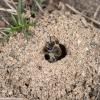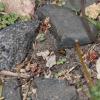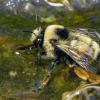A version of this article originally appeared in the Fall 2021 issue of Wings.
There was a teacher at my high school who started every class with the key take-home message he wanted to be sure we all heard. Following his example, here is a message I hope you’ll take to heart: If we are to bring back pollinators and restore the biodiversity that our world needs to survive, we must curtail the excessive use of pesticides—at home, on the farm, and everywhere in between.
The use of pesticides, which include insecticides, herbicides, fungicides, acaricides, and other “cides,” is woven into the fabric of people’s thinking about how they protect their plants from pests. The norm in pest management is to reach for a pesticide. But pesticides are not a silver bullet for dealing with unwanted insects, diseases, or other “pests”; if it were, would we still have pest problems? The fact is that the widespread use of chemicals has led to pervasive contamination.
Pesticides are pervasive in our environment
Pesticides are found almost everywhere we look: high mountain lakes, rainwater, honey collected from bee hives, home gardens even where pesticides are not used, field edges, the milkweed plants monarch caterpillars feed on, the pollen of nursery plants marketed as pollinator attractive—the list goes on. Even the Arctic isn’t safe from pesticides, since some long-lived, highly mobile pesticides are found there, thousands of miles from where they are used.
Sometimes the pesticides detected in the environment are at levels high enough to kill beneficial insects outright. More often lower levels are found, and we refer to those levels that might not immediately kill a bee, butterfly, or other beneficial insect as “sublethal.” But that term can be misleading, because even if they don’t kill, these lower levels of contamination can have devastating effects. Imagine a monarch that can’t migrate, a queen bumble bee that can’t survive hibernation, or a bee that is unable to fight off parasites because it used its energy reserves to detoxify from a pesticide exposure. Moreover, sublethal impacts can be compounded, since it’s rare for just a single pesticide to be found in isolation.

An ever-growing number of people are rejecting pesticides and seeking out more-sustainable ways to garden. Photograph by Mike Licht, Flickr.
Pesticide regulation is riddled with loopholes
This troubling pesticide contamination across the landscape isn’t caused by misapplications or a few rogue applicators using too many chemicals. Rather, a number of factors are at play here, starting with the existing regulatory structure. Current federal pesticide regulation is riddled with loopholes. The fact that each pesticide is regulated individually, without regard for the compounding impact when multiple chemicals are applied, is a perfect example of how regulations fail to protect.
But the troubles with pesticide regulation go much deeper. A recent investigative-journalism report published in The Intercept spotlighted an entrenched regulatory structure and culture that values profits over safety. Many pesticide products are put on the market without sufficient research into their risks—and sometimes in spite of research warning of severe repercussions. The push to get pesticides to market, even when they could cause significant harm, is in part due to the mindset that pesticides are necessary and that the benefits of their use outweigh the risks.
This mindset isn’t unique to the regulators who rubber-stamp pesticide registrations. All too frequently people see pesticides as their go-to option. And, although home gardeners, farmers, park managers, and others often want to limit pesticide use, they don’t trust that they can respond to such concerns as yellowjackets, invasive weeds, or plant diseases without them.
Finding safer solutions through non-chemical pest management
So here is where we get to the grape juice and vacuums: both are employed in non-chemical pest management. People are definitely getting creative in managing the places where we live, work, and play to make them safer for everyone.
Take the work of Xerces’ integrated pest and pollinator management specialist in New Hampshire, Alina Harris, who is joining with partners to respond to the economically damaging and hard to control—and recently introduced—spotted wing drosophila (Drosophila suzukii). Alina is working in collaboration with berry growers, conservation districts, the University of New Hampshire Cooperative Extension, and the New Hampshire Natural Resource Conservation Service to conduct trials on the use of insect-exclusion netting to cover crops and keep the drosophila out. Funding was provided by the New Hampshire NRCS to offset some of the initial costs of buying the netting. Alina recommends other ways to minimize fruit damage caused by the flies, such as frequent picking and basic sanitation measures to remove and destroy infested fruit from the field. She is also excited by the work of researchers at the University of Massachusetts, who are conducting trials on the use of traps baited with grape juice to attract and kill the fruit flies.

In New Hampshire, farmers facing a recently introduced fruit fly pest are experimenting with non-pesticide methods to protect crops, such as exclusion netting. Photograph by Jeremy DeLisle, University of New Hampshire.
By building connections between people working on similar issues, we are turning isolated efforts into mainstream ideas. At a Bee City USA webinar, attended by hundreds of people from across the country, the parks and open space manager in Eugene, Oregon, explained how he and his staff are able to maintain city lands sustainably. He described how reducing pesticide use starts in the project-planning phase – selecting hardy, climate-resilient native plants that are resistant to common pest pressures. The city has also experimented with and adopted a number of effective non-chemical pest-management techniques. In the past when yellowjackets built a nest in a location that sees a lot of human traffic, the city would spray insecticides into the nest. Now staff members don bee suits and vacuum out the nest. City staff were skeptical at first, but once they were convinced that the suits would protect them they were quick to accept the technique. When peers exchange stories like these, they are also sharing practical knowledge about ways to expand the use of sustainable land-management practices.
Another area where Xerces is encouraging dialogue around biodiversity and smarter management techniques is in the growing of nursery plants. In California, long-time native-plant nursery Hedgerow Farms employs disinfectant foot baths for visitors, as well as self-draining metal slatted tables to avoid Phytophthora pathogen. The Iwasaki Brothers Greenhouse in Oregon uses “trap plants” such as eggplants and marigolds that are highly attractive to certain pests, to serve as early indicators of growing infestations.
No matter who you are or what size land you manage—from a few potted plants to a large farm—you can be part of the effort to protect the invertebrates that support the ecosystems on which we all rely. We greatly appreciate the work of those of you who have already adopted conservation-focused ways to manage the space you occupy in this world. Keep it up! Your efforts are providing a roadmap for others to follow. And for those of you haven’t already, we hope you’ll join us and the many others around the globe who are quietly transforming land management.
Further reading:
The Risks of Pesticides to Pollinators



